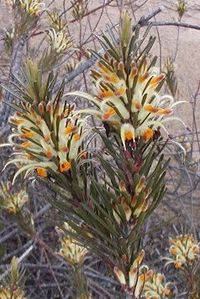Adenanthos detmoldii: Difference between revisions
Created page with '{{SPlantbox |familia=Proteaceae |genus=Adenanthos |species=detmoldii |common_name=Scott River jugflower, Yellow jugflower |name_ref=Flora - A Gardener's Encyclopedia |habit=shr…' |
No edit summary |
||
| Line 1: | Line 1: | ||
{{SPlantbox | {{SPlantbox | ||
|familia=Proteaceae | |familia=Proteaceae | ||
|genus=Adenanthos | |genus=Adenanthos | ||
|species=detmoldii | |species=detmoldii | ||
|common_name=Scott River jugflower, Yellow jugflower | |common_name=Scott River jugflower, Yellow jugflower | ||
|name_ref=Flora - A Gardener's Encyclopedia | |name_ref=Flora - A Gardener's Encyclopedia | ||
| Line 25: | Line 25: | ||
|usda_ref=Flora - A Gardener's Encyclopedia | |usda_ref=Flora - A Gardener's Encyclopedia | ||
|max_zone=10 | |max_zone=10 | ||
|image= | |image=Adenanthos detmoldii Cranbourne email.jpg | ||
|image_width= | |image_width=200 | ||
}} | }} | ||
'''''Adenanthos detmoldii''''', commonly known as '''Scott River Jugflower''' or '''Yellow Jugflower''',<ref name = "Wrigley 1991">{{cite book | last = Wrigley | first = John |coauthors = Fagg, Murray | title = Banksias, Waratahs and Grevilleas | year = 1991 | publisher = Angus & Robertson | location = Sydney | isbn = 0-207-17277-3|pages = 61–62}}</ref> is a species of shrub in the family [[Proteaceae]]. It is endemic to the [[Southwest Australia|south-west]] of [[Western Australia]]. | |||
It grows as an erect shrub to 4 m (13 ft) in height, with hairy branches and long, narrow leaves up to 80 mm length and about 5 mm wide. The flowers, which appear between August and November, consist of a tubular perianth about 25 mm long, and a style about 40 mm long. The perianth is yellow with an orange throat that becomes brown following pollination.<ref name="Nelson 1995">{{cite encyclopedia | author = Nelson, Ernest Charles | year = 1995 | title = Adenanthos | editor = McCarthy, Patrick (ed.) | encyclopedia = [[Flora of Australia (series)|Flora of Australia]] | volume = 16 | pages = 314–342 | location = Collingwood, Victoria | publisher = CSIRO Publishing / Australian Biological Resources Study | isbn = 0643056920}}</ref> | |||
==Cultivation== | ==Cultivation== | ||
The species prefers well-drained, light soils in full sun to part shade,<ref name="ANPSA">{{cite web | title = ''Adenanthos detmondii'' | publisher = Australian Native Plant Society (Australia) | url = http://asgap.org.au/a-det.html | accessdate = 2010-03-21}}</ref> though, as its natural occurrence in winter-wet areas would suggest, it is hardier to poor drainage than most ''Adenanthos'' species.<ref name="Wrigley 1991"/> Naturally a dry-summer plant, it performs unexpectedly well in areas with wet or humid summers, though it is vulnerable to [[grey mould]] in such climates. [[Plant propagation|Propagation]] is by [[cutting (plant)|cutting]]s of semi-mature growth.<ref name="ANPSA"/> | |||
===Propagation=== | ===Propagation=== | ||
| Line 40: | Line 42: | ||
==Varieties== | ==Varieties== | ||
''A. detmoldii'' was retained in ''A.'' sect. ''Eurylaema'' in [[Ernest Charles Nelson]]'s 1978 revision of ''Adenanthos'',<ref name="Nelson 1978"/> and again in his 1995 treatment of the genus for the ''[[Flora of Australia (series)|Flora of Australia]]'' series. The placement of ''A. cuneatus'' in [[Nelson's taxonomic arrangement of Adenanthos|Nelson's arrangement of ''Adenanthos'']] may be summarised as follows:<ref name="Nelson 1995"/> | |||
:'''''[[Adenanthos]]''''' | |||
::'''[[Adenanthos sect. Eurylaema|''A.'' sect. ''Eurylaema'']]''' | |||
:::'''''A. detmoldii''''' | |||
:::''[[Adenanthos barbiger|A. barbiger]]'' | |||
:::''[[Adenanthos obovatus|A. obovatus]]'' | |||
:::''[[Adenanthos ×pamela|A. ×pamela]]'' | |||
::[[Adenanthos sect. Adenanthos|''A.'' sect. ''Adenanthos'']] (29 species, 8 subspecies) | |||
This species frequently [[hybrid (biology)|hybrid]]ises with ''[[Adenanthos obovatus]]''; the resulting hybrids are known as ''[[Adenanthos ×pamela]]''.<ref name="Nelson 1995"/> | |||
==Gallery== | ==Gallery== | ||
<gallery perrow=5> | <gallery perrow=5> | ||
File:Adenanthos detmoldii foliage.jpg|Foliage | |||
Image:Upload.png| photo 1 | Image:Upload.png| photo 1 | ||
Image:Upload.png| photo 2 | Image:Upload.png| photo 2 | ||
Latest revision as of 00:40, 10 November 2010
| Adenanthos detmoldii subsp. var. | Scott River jugflower, Yellow jugflower | |||||||||||||||||||||||||||||||||||||||||||||||||||||||
|---|---|---|---|---|---|---|---|---|---|---|---|---|---|---|---|---|---|---|---|---|---|---|---|---|---|---|---|---|---|---|---|---|---|---|---|---|---|---|---|---|---|---|---|---|---|---|---|---|---|---|---|---|---|---|---|---|

|
|
| ||||||||||||||||||||||||||||||||||||||||||||||||||||||
| ||||||||||||||||||||||||||||||||||||||||||||||||||||||||
Adenanthos detmoldii, commonly known as Scott River Jugflower or Yellow Jugflower,[1] is a species of shrub in the family Proteaceae. It is endemic to the south-west of Western Australia.
It grows as an erect shrub to 4 m (13 ft) in height, with hairy branches and long, narrow leaves up to 80 mm length and about 5 mm wide. The flowers, which appear between August and November, consist of a tubular perianth about 25 mm long, and a style about 40 mm long. The perianth is yellow with an orange throat that becomes brown following pollination.[2]
Cultivation
The species prefers well-drained, light soils in full sun to part shade,[3] though, as its natural occurrence in winter-wet areas would suggest, it is hardier to poor drainage than most Adenanthos species.[1] Naturally a dry-summer plant, it performs unexpectedly well in areas with wet or humid summers, though it is vulnerable to grey mould in such climates. Propagation is by cuttings of semi-mature growth.[3]
Propagation
Pests and diseases
Varieties
A. detmoldii was retained in A. sect. Eurylaema in Ernest Charles Nelson's 1978 revision of Adenanthos,[4] and again in his 1995 treatment of the genus for the Flora of Australia series. The placement of A. cuneatus in Nelson's arrangement of Adenanthos may be summarised as follows:[2]
- Adenanthos
- A. sect. Eurylaema
- A. detmoldii
- A. barbiger
- A. obovatus
- A. ×pamela
- A. sect. Adenanthos (29 species, 8 subspecies)
- A. sect. Eurylaema
This species frequently hybridises with Adenanthos obovatus; the resulting hybrids are known as Adenanthos ×pamela.[2]
Gallery
-
Foliage
-
photo 1
-
photo 2
-
photo 3
References
- ↑ 1.0 1.1 Wrigley, John; Fagg, Murray (1991). Banksias, Waratahs and Grevilleas. Sydney: Angus & Robertson. pp. 61–62. ISBN 0-207-17277-3.
- ↑ 2.0 2.1 2.2 Template:Cite encyclopedia
- ↑ 3.0 3.1 "Adenanthos detmondii". Australian Native Plant Society (Australia). Retrieved on 2010-03-21.
- ↑ Cite error: Invalid
<ref>tag; no text was provided for refs namedNelson 1978
External links
- w:Adenanthos detmoldii. Some of the material on this page may be from Wikipedia, under the Creative Commons license.
- Adenanthos detmoldii QR Code (Size 50, 100, 200, 500)

